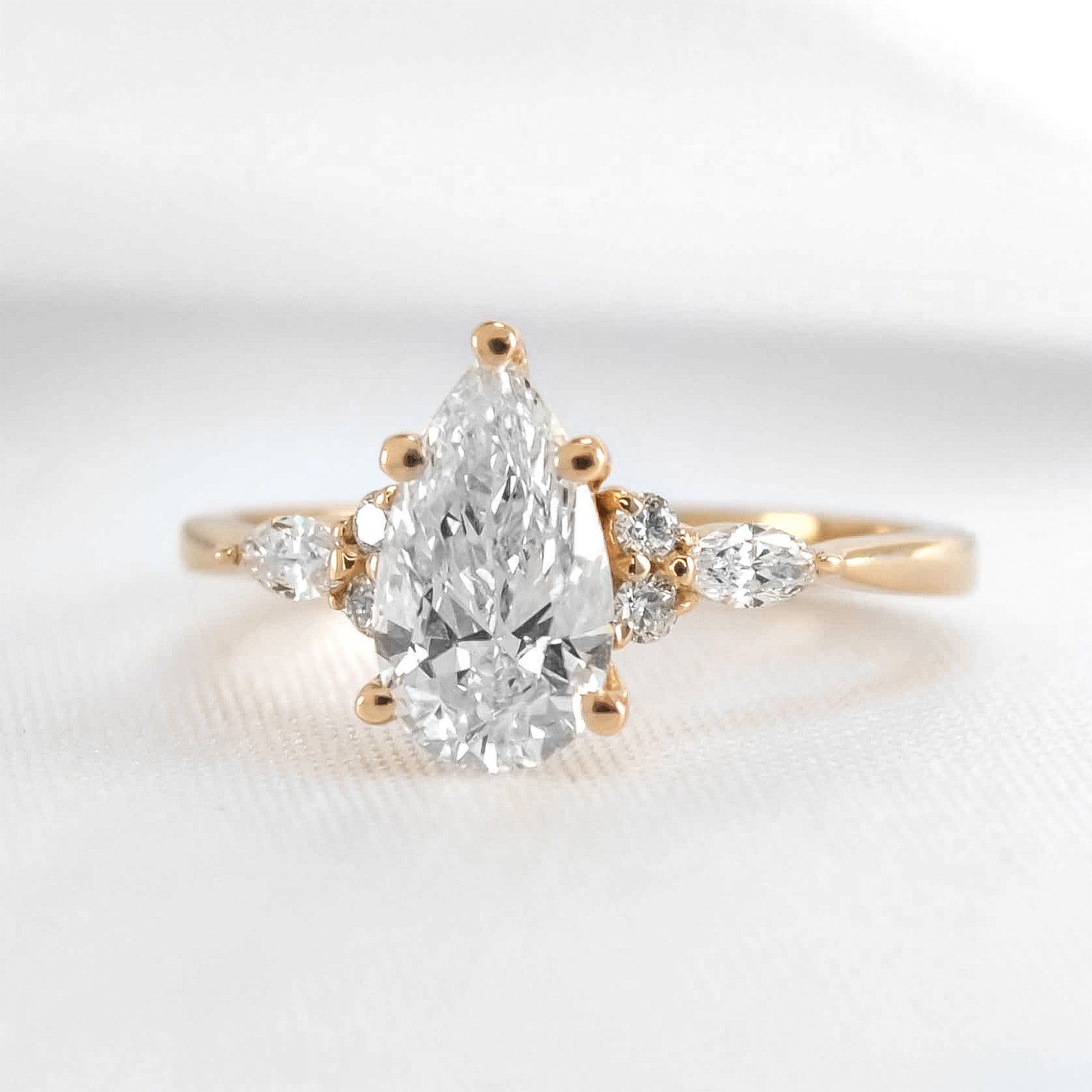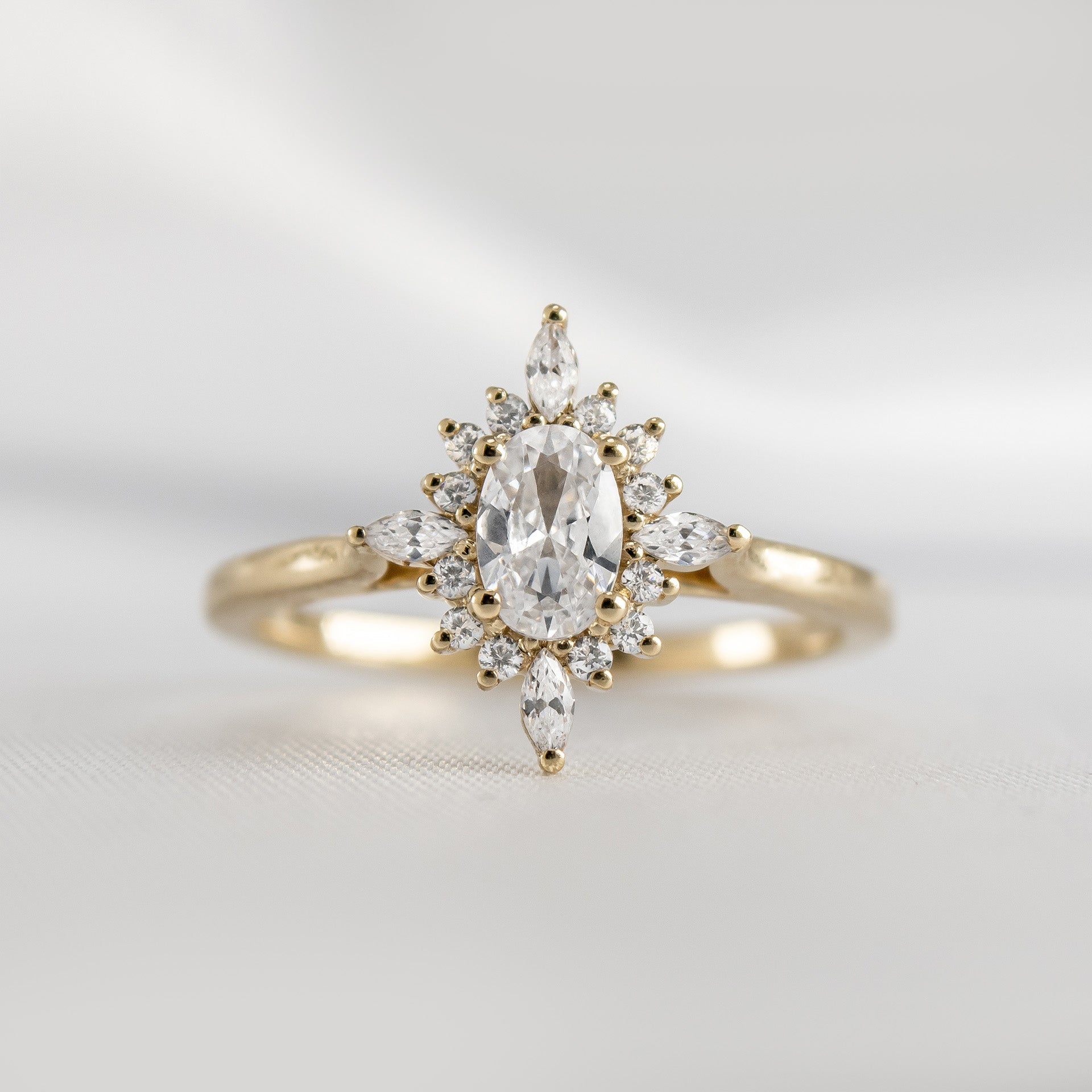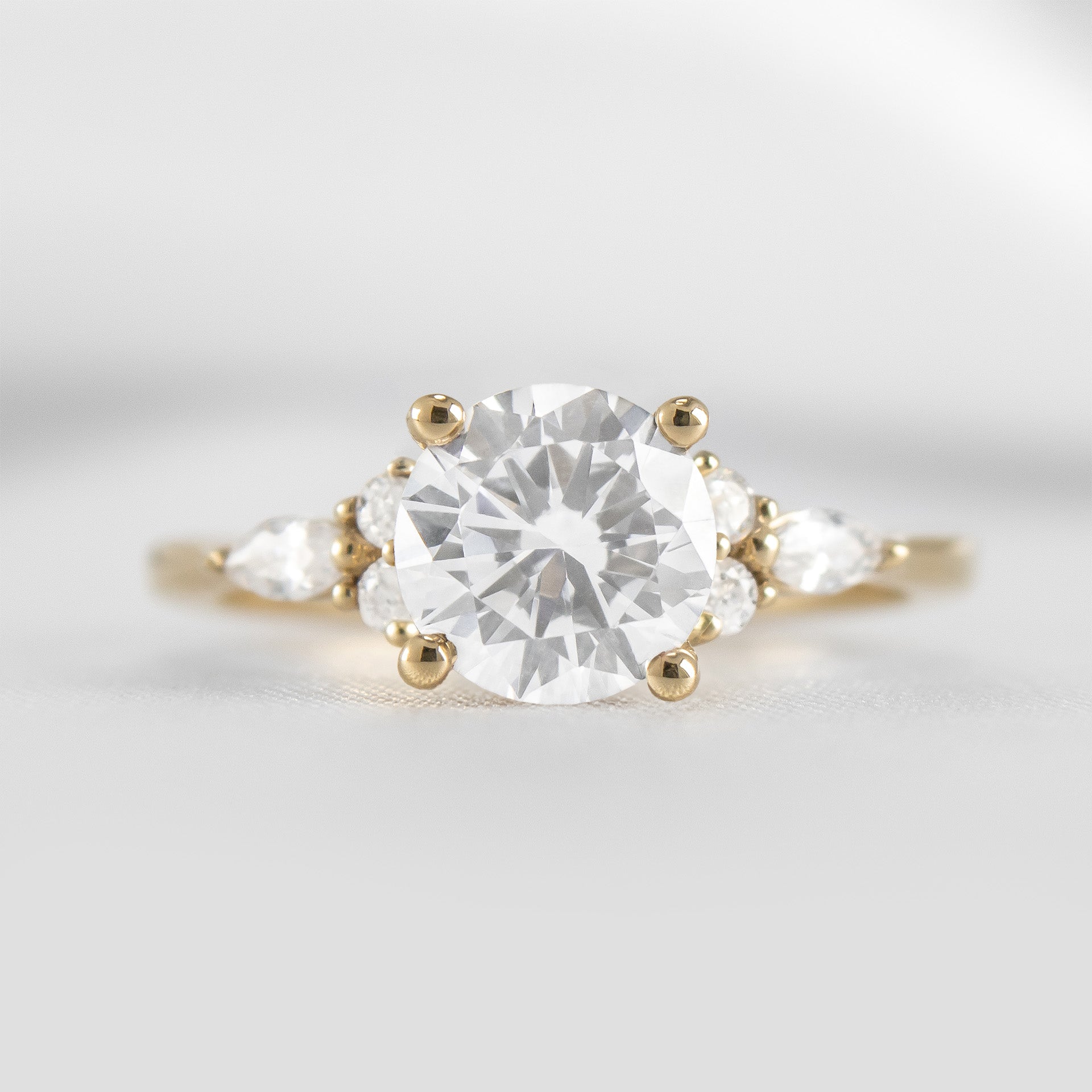
DIAMOND GUIDES
Lab Grown Diamonds VS Moissanite VS Cubic Zirconia
Learn the differences between them, which is an imitation, and why you might consider moissanite for your engagement ring.
Curious about whether lab-created or natural diamonds are the best choice for you? Get exclusive access to our detailed guide and make an informed decision with confidence.
Understanding the Differences Between Diamond, Cubic Zirconia, and Moissanite
When it comes to engagement rings, diamonds have long been considered the gold standard. Known for their rarity, durability, and unmatched brilliance, diamonds have symbolized love and commitment for centuries. However, in recent years, alternative gemstones like lab grown diamonds and moissanite have gained popularity for their affordability and impressive visual appeal. To make an informed decision, it's essential to understand the characteristics that set these stones apart.
Natural Diamonds are formed deep within the Earth's mantle under high pressure and temperature. Their unique atomic structure gives them exceptional hardness, making them the hardest substance known to man. Diamonds are graded based on the 4Cs - cut, color, clarity, and carat weight - which determine their value and overall quality. The cut affects the stone's brilliance, while color refers to the presence of any yellow or brown tints. Clarity measures the presence of internal flaws or blemishes, and carat weight determines the size of the diamond. Diamonds have a timeless appeal and are considered a symbol of luxury and prestige.
Lab grown diamonds, or also called lab created diamonds because they are created in a laboratory, unlike mined diamonds that occur naturally and are extracted from the earth. They come in various shapes and sizes and have almost identical chemical structures. There is no visible difference between these two types of diamonds, as lab diamonds look and feel precisely like mined diamonds. Lab-created diamonds are in fact real diamonds and offer the same brilliance, sparkle, and shine of a mined, natural diamond.
Natural diamonds are formed over millions of years due to intense heat and pressure, while lab-grown diamonds can be produced in just a few weeks. Mined diamonds may contain a little nitrogen, but synthetic diamonds do not. Despite their similarities, there is a significant price difference between the two.
Moissanite, a relatively new gemstone, is another popular alternative to diamonds. Originally discovered in a meteor crater, moissanite is now created in laboratories. It shares many similarities with diamonds, including exceptional brilliance and fire. In fact, moissanite has a higher refractive index than diamonds, meaning it reflects more light and sparkles even more. Moissanite is also more affordable than diamonds, making it an attractive option for budget-conscious buyers. However, its popularity has raised concerns about its environmental impact, as lab-created gemstones require significant energy and resources to produce.
Cubic zirconia (CZ), on the other hand, is a synthetic gemstone made from zirconium dioxide. While it closely resembles a diamond in appearance, it is extreemly inexpensive. The main advantage of cubic zirconia is its stunning visual appeal. CZ stones have excellent clarity and brilliance, often surpassing that of lower-grade diamonds. However, cubic zirconia is not as durable as diamonds and may show signs of wear over time. It is also more prone to scratching and may require occasional replacement. If you view moissanite vs cubic zirconia side by side, you would seem more color from the moissanite. Lisa Robin does not offer cubic zirconia engagement rings.
Many people wonder, 'Is a lab created diamond the same as cubic zirconia?' The answer is a resounding no. Lab created diamonds and cubic zirconia are fundamentally different materials. Lab diamonds are chemically, physically, and optically identical to natural diamonds - they're both pure carbon and share the same crystal structure. Cubic zirconia, on the other hand, is made of zirconium dioxide and only mimics the appearance of a diamond. While both are created in laboratories, lab diamonds possess the same hardness, durability, and fire as natural diamonds, whereas cubic zirconia is softer, less durable, and has different optical properties. In essence, a lab created diamond is a real diamond, just with a different origin, while cubic zirconia is a diamond simulant designed to look similar to a diamond at a much lower cost.
In the next sections, we'll delve deeper into the pros and cons of each stone, helping you make an informed decision that aligns with your preferences, budget, and values.
Lab created diamonds are carbon-based as are natural diamonds, so they are "real" diamonds - unlike cubic zirconia or moissanite. These diamond simulants are also created in a lab, but they do not contain carbon atoms and are therefore not real diamonds.
Natural diamonds and lab created diamonds are inherently alike in appearance, feel and hardness, but a simulant option like cubic zirconia or moissanite differs in appearance, feel, and hardness.
Pros and Cons of Natural or Lab Diamond Engagement Rings
Pros:
- Timeless Beauty: Diamonds have an unrivaled beauty that has captivated individuals for centuries. Their sparkle and brilliance make them a symbol of everlasting love and commitment.
- Durability: Diamonds are renowned for their exceptional hardness. They are resistant to scratches, making them a practical choice for everyday wear.
- Ethical Concerns: The natural diamond industry has faced scrutiny regarding ethical issues such as conflict diamonds, also known as blood diamonds. These are diamonds mined in war zones and sold to finance armed conflict against governments. Since lab diamonds are created in a laboratory they eliminate this issue.
- Environmental Impact: Lab Diamonds are considered more sustainable. Natural diamond mining can have a negative impact on the environment, particularly in areas where mining practices are not regulated. The extraction process can lead to deforestation, soil erosion, and water pollution.
Cons:
- Cost: Diamond cost can be a financial factor. The price of a diamond is determined by its quality and carat weight, and larger or higher-quality diamonds are priced higher. Lab created diamonds are less expensive than natural diamonds.
- Investment Value: Lab created diamonds are in abundant supply which may reduce their value over time.
SHOP BY POPULAR STYLES with Lab grown Diamonds
Moissanite is a rare mineral composed of silicon carbide that occurs naturally in upper mantle rock and meteorites. However, due to its scarcity, it is mostly lab grown with minimal environmental impact. In the late 1990s, researchers in North Carolina developed and patented a process for creating pure silicon carbide (SiC) which was primarily used in industry. It was then that the vision and innovation of Charles & Colvard—the original creator of moissanite—to produce moissanite in a laboratory, as a diamond simulant for use in jewelry.
Frequently Asked Questions About Moissanite
Is Moissanite less expensive than a Lab diamond?
Yes, Moissanite is typically less expensive than a lab diamond. However, as lab diamonds become increasing more competitively priced, the difference in price between a Moissanite and lab diamond is becoming less and less. The price Moissanite compared to a natural diamond, however is significant and how Moissanite gained its reputation for being a budget friendly alternative to a diamond.
Is moissanite better than cubic zirconia?
Moissanite's remarkable refractive index of 2.69 results in an impressive 25% higher light refraction compared to Cubic Zirconia, enhancing its allure and making it a more sought-after gemstone.
Moissanite outshines Cubic Zirconia in terms of durability. Thanks to its exceptional hardness, Moissanite is more resistant to scratches and wear, making it an ideal choice for everyday jewelry. This endurance, combined with its brilliance, further elevates Moissanite's desirability over Cubic Zirconia
Will moissanite pass a diamond tester?
Most diamond testers gauge a range of gemstones, identifying Diamond, Moissanite and other colored gemstones by reading the amount of light that passes through the stone via the Refractive Index.
Which is more sparkly moissanite or cubic zirconia?
Moissanite's dispersion of light is 58% greater than a CZ which gives Moissanite more fire, or flashes of rainbow light, than CZ. Moissanite also refracts more light than a CZ.
How to tell the difference between a diamond and moissanite and cubic zirconia?
Using a tester to read the amount of light that passes through the stone via the Refractive Index is the definitive way to tell them apart.
When it comes to color, Moissanite used to have a yellowish or greenish tint, but manufacturers have improved the creation process, resulting in high-quality, colorless Moissanite. It is graded on a scale similar to diamonds.
Pros and Cons of Moissanite Engagement Rings
- Brilliance and Fire: Moissanite is known for its exceptional brilliance and fire, often surpassing that of diamonds. Its high refractive index gives it a unique sparkle that catches the eye.
- Affordability: Moissanite is more affordable than natural diamonds, allowing you to get a larger stone for your budget. In today's market, there is a modest difference in pricing between moissanite and lab created diamonds.
- Eco-Friendliness: Lab-created moissanite is a more sustainable choice compared to mined diamonds. By opting for moissanite, you can reduce the environmental impact associated with diamond mining.
Cons:
- Authenticity: Some individuals may prefer the authenticity and prestige associated with diamonds. Moissanite may not carry the same sentimental value or symbolic meaning.
- Limited Availability: While moissanite is becoming more popular, it may not be as widely available as diamonds. This can make it more challenging to find the perfect moissanite engagement ring.
- Environmental Impact: While moissanite is more eco-friendly compared to mined diamonds, it is still a lab-created gemstone that requires significant energy and resources to produce. Its overall sustainability may vary depending on the manufacturing process. Moissanite and lab created diamonds are comparable since they are both created in a lab.
Shop Moissanite Engagement Rings
View allWhat is Cubic Zirconia?
Cubic zirconia was originally identified in 1937 by German mineralogists, but it wasn't until 1977 when Russian scientists discovered how to actually grow these crystals using a synthetic process. They named their synthetic crystals Djevalite and tried to market them as simulated diamonds without much success. In the 1980's Swarovski created its own version of cubic zirconia. Swarovski coined the abbreviated term CZ for cubic zirconia. This was the jumpstart this crystal needed to become a popular in cheaper costume jewelry as a substitute for real diamond jewelry.
Both moissanite and cubic zirconia do not have the same brilliance and sparkle as real diamonds. Diamond refract white light. Cubic zirconia has a lower refractive index than diamonds, 2.22 versus 2.42, and reflects more colored light. Moissanite, however, has a higher refractive index (2.65 – 2.69). Because moissanite has a high refractive index, it reflects vivid rainbow colors.
There is a difference in hardness. On the Mohs scale of hardness, diamonds score a 10, moissanite between 9 and 9.5, and cubic zirconia 8. That means moissanite and cubic zirconia may show wear over time.
what is the difference between cubic zirconia and moissanite?
Cubic Zirconia (CZ) and Moissanite are both popular diamond alternatives, but they differ significantly in composition, appearance, and properties. Cubic Zirconia is a synthesized crystalline material made of zirconium dioxide. It's known for its affordability and its diamond-like appearance, though it's much softer than a diamond and can quickly lose its brilliance due to scratches and cloudiness over time.
On the other hand, Moissanite is composed of silicon carbide and was originally discovered in meteorites. It's nearly as hard as a diamond making it more durable and scratch-resistant than CZ. Moissanite is also known for its high refractive index and strong fire, often displaying more colorful flashes of light than a diamond.
Pros and Cons of Cubic Zirconia Engagement Rings
- Affordability: Cubic zirconia is very inexpensive compared to diamonds or moissanite.
- Availability: Cubic zirconia is readily available and can be found in a wide range of shapes, sizes, and colors, giving you more options to choose from.
Cons:
- Durability: While cubic zirconia is relatively durable, it is not as hard as diamonds. CZ stones can become scratched or damaged over time, especially with daily wear.
- Authenticity: Some individuals prefer the authenticity and prestige associated with diamonds. Cubic zirconia may not carry the same sentimental value or symbolic meaning.
- Replacement: Due to its lower durability, cubic zirconia may need to be replaced more frequently than diamonds. This can be an additional cost to consider in the long run.
What is the difference between lab created diamonds and cubic zirconia?
Lab-created diamonds are chemically identical to natural diamonds, made from pure carbon through processes like high-pressure high-temperature (HPHT) or chemical vapor deposition (CVD). They share the same hardness, brilliance, and clarity as mined natural diamonds. On the other hand, cubic zirconia (CZ) is a diamond simulant made from zirconium dioxide, not carbon. It's softer, less durable, and displays more colorful reflections but less brilliance than diamonds. CZ is also much more affordable than both lab-created and natural diamonds.
Frequently Asked Questions About Cubic Zirconia
What is Cubic Zirconia?
A cubic zirconia or CZ is an affordable alternative to diamonds, artificially created in a laboratory. Commercial production began in the 1970s.
Does Lisa Robin offer cubic zirconia engagement rings?
No, Lisa Robin does not offer cubic zirconia engagement rings. We focus on diamond, either lab grown or natural and other alternative gemstones.
What is the Difference Between Cubic Zirconia and Diamond?
A CZ is heavier than diamonds but less hard. It rates 8.5 on the Mohs scale, while diamonds rate 10. CZ is often sold as "diamond equivalent" in carat weight, can be colorless, and exhibits more color bursts than diamonds.
Is cubic zirconia a lab diamond?
No. A cubic zirconia (CZ) is a diamond simulant made from zirconium dioxide, not carbon. Though they are both created in a lab, lab-created diamonds are chemically identical to natural diamonds, made from pure carbon.
Are There Different Grades of Cubic Zirconia?
Graded using the Four Cs (Color, Cut, Carat Weight, Clarity), CZ quality varies with the manufacturer. Grades range from A (lowest) to AAAAA (highest).
Is Cubic Zirconia used in Engagement Rings?
CZ is not as durable as diamonds but can be a temporary alternative for engagement rings due to its lower cost. Lisa Robin does not sell cubic zirconia engagement rings.
How do you Clean Cubic Zirconia Jewelry?
Use ultrasonic jewelry cleaners or a soft-bristled brush with dishwashing detergent. It's important to consider the setting materials before cleaning.
What is the difference between Cubic Zirconia and Zircon?
CZ, a zirconium dioxide, is different from Zircon, a zirconium silicate rated 6-6.5 on the Mohs scale. Zircons often undergo heat treatment to enhance color.
Conclusion
Choosing an engagement ring is a significant decision that involves considering various factors, including your budget, personal preferences, and style considerations. While diamonds have long been the traditional choice, alternative gemstones like moissanite offer affordable and visually stunning options. By understanding the pros and cons of each stone and evaluating your priorities, you can make an informed decision that suits your style, budget, and values.
Remember, the perfect engagement ring is a symbol of your love and commitment, and it should bring you joy every time you wear it. Whether you choose a natural diamond, lab diamond, or moissanite, the most important thing is that it represents your unique love story
That’s why we are here to guide you through every step - from understanding what carat, color, cut and clarity mean, to designing the perfect ring.























